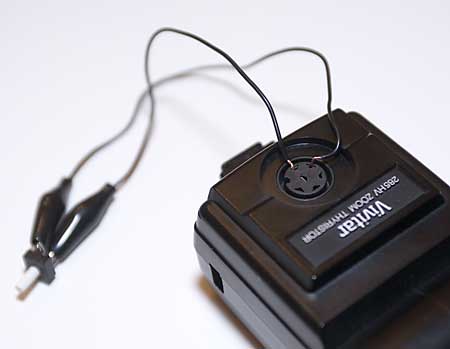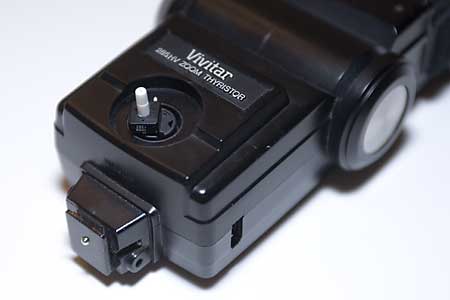Variable Vivitar 283-285 - follow up
TODO: Link prior post (TKTKTK)
Yep. It works.
I stopped by radio shack on the way home yesterday and picked up a box of assorted resistors (my local shop didn't have a single 100k Ohm potentiometer by itself). My flash is a 285 which has a little different pin out for the sensor. If you are looking directly at the flash, the resistor should be wired into the lowest socket in the center and the lower one on the left.
Here is a shot of my first test using gator clips to wire up the flash.

After confirming that this worked, I bent the pins on the potentiometer and socketed it directly.
(Technically, the potentiometer is really being used as a rheostat since only two of its three pins are connected.)

All that's left now is to epoxy the parts together and you end up with a handy-dandy continuously variable manual strobe.
In testing, with the dial in place, the max output of the strobe was about one stop under what it was without modification. Looking up online, one unofficial site has the resistance settings listed as 1/16 power at 24k, 1/4 power at 92k, 1/2 power at 168k, and an open circuit for full power.
I'm not sure, but I think this means that using a 200k Ohm potentiometer instead of a 100k Ohm will get you back to full steam.
So, last night while I was trying to go to sleep my mind kinda latch onto this and would let go. A potential next step would be to replace the potentiometer with a microcotroller and a set of resistors.
The microcotroller could be setup to be run by remote control to choose a specific resistor set thereby providing the ability to adjust flash output without having to mess with the flash setup itself.
By assigning each flash/controller setup a unique number, it would then be possible to setup lighting patters and easily switch between them. The specific application I'm thinking of would be shooting a band on stage. You could have a bunch of flashes setup around and above the stage before the show then switch out the lighting patterns during the performance from the floor.
I'm envisioning the master controller being driving by a Treo or something with a touch screen so you could just tap "pattern 1" and it would light the lead singer from the side with a little back light.
I've shot in a lot of bars with shitty lighting. Getting a setup like this would mean that given a little time, a ladder, and permission of the owner and band, you could get some really well lit shots.